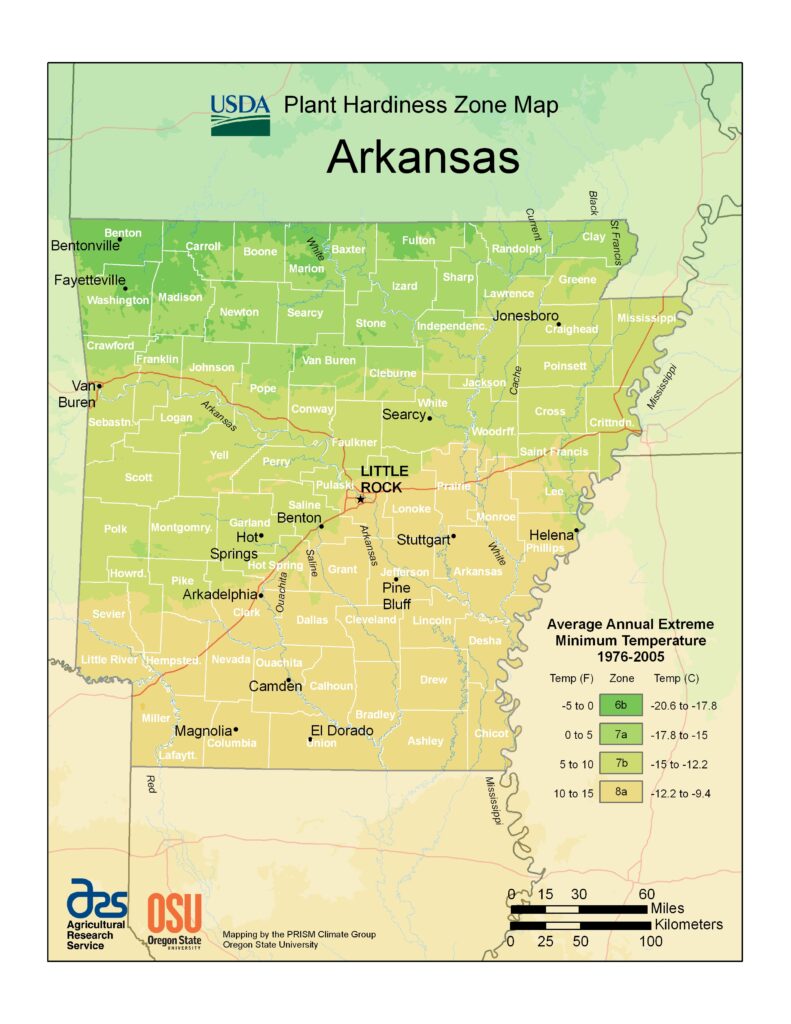The USDA Plant Hardiness Zone is an important reference for gardeners to understand their climate and how that affects the plants that are grown in their particular location. This article will take a look at the USDA Hardiness Zones in Arkansas, what these zones mean, and provides an understanding of the climate and influencing factors and how that relates to plants. This article will answer the question: What Zone is Arkansas for Plants?
Arkansas, the 25th state, has varying climates throughout each region of the state with mountainous elevation being a big factor. There are mountainous regions of the Ozark and Ouachita Mountains, dense forests in the South, lowlands in the East near the Mississippi River, and the Arkansas Delta.
Arkansas is surrounded by states on all sides including the states of Missouri (North), Mississippi and Tennessee (East), Texas and Oklahoma (West), and Louisiana (South).
The question that this post answers is what Zone is Arkansas for plants and how that zone will affect you.
What USDA Hardiness Zone exists in Arkansas?
The US Department of Agriculture designates different plant hardiness zones based on the region and climate of the state. Use these plant hardiness or gardening zones as a reference to better understand what species of plant to grow either as an annual or on a perennial basis. These zones are based primarily on the average lowest temperatures in each specific zone.
If you are wondering what zone is Arkansas for plants, then you are in the right place!
Perennials vs. Annual Plants
Perennial plants regrow every spring, while annual plants live for only one growing season, and then die off. Perennials generally have a shorter blooming period compared to annuals. So, it’s common for gardeners to use a combination of both plants in their yard.
Understanding the USDA Plant Hardiness Zone, the climate, and soil types, amongst other factors, gives a gardener a real chance to have a successful vegetable and/or flower garden. Review this article and prepare to do just that.
USDA Plant Hardiness Zones
The USDA (United States Department of Agriculture) has established different plant hardiness zones throughout the United States. The following image shows the USDA Hardiness Zone maps for the entire country, the South-Central region, and the state of Arkansas:
The question is what Zone is Arkansas for Plants? Which zone are you in?
USDA Plant Hardiness Zones for the USA
The map below shows the wide range of hardiness zones for all states in the country.

USDA Plant Hardiness Zones for the South-Central Region
The Plant Hardiness maps for the South-Central region include the states of Oklahoma, Texas, Arkansas, and Louisiana.

USDA Plant Hardiness Zones for Arkansas
The Plant Hardiness Zone Map for the entire state of Arkansas is shown below.

Arkansas Regions in USDA Plant Hardiness Zones
The state of Arkansas contained 75 counties.
As you can tell from the USDA Plant Hardiness Zone Map of Arkansas, there are 4 distinctly different climates and plant hardiness zones. These zones range from Zone number 6B to 8A.
Differences in the average maximum and minimum temperatures, along with first and last frost dates, are all part of the criteria for each USDA Plant Hardiness Zone.
Generally, Arkansas sees hot summers and relatively mild winters, at lower elevations, but does see temperatures a bit cooler with an increase in elevation.
Gardening is Local
Somebody once said that “gardening is local”. This means that each gardener needs to evaluate their soil, climate, or micro-climate, along with the USDA Plant Hardiness Zone, first and last frost dates, and what plants can be hardy enough to survive the extreme winter temperatures experienced in your specific garden location. In some cases, it may be hard to pinpoint if you are in one zone versus an adjacent zone. Think about your “local” conditions to ensure you have a successful garden.
What Zone is Arkansas for Plants?
Far North Arkansas (Zone 6B)
Zone 6B is the region at the very top of Arkansas. It includes portions of Benton, Washington, Carroll, and Madison parishes, among other Counties, and includes towns such as Bentonville and Fayetteville. The average annual extreme minimum temperature is -5 to 0 degrees F (degrees Fahrenheit) in Zone 6B.
Upper North Arkansas (Zone 7A)
Zone 7A represents mostly northern counties that are not in 6B including Searcy, Izard, Sharp Randolph, and Clay, among other northern parishes. Towns include Pocahontas, and Piggott, among others. The average minimum temperature is 0 to 5 degrees F in Zone 7A.
North Central Arkansas (Zone 7B)
Zone 7B represents mostly central northern counties including White, Craighead, Mississippi, Montgomery, and Garland, among other north central parishes. Towns include Benton, Searcy, Jonesboro, and Hot Springs, among others. The average minimum temperature is 5 to 10 degrees F in Zone 7B.
Central and Southern Arkansas (Zone 8A)
Zone 8A represents the southern and central southern counties including Little River, Dallas, Jefferson, and portions of Pulaski, among others. Towns include Little Rock, Pine Bluff, and Arkadelphia. Most parishes from Little Rock and down to the southern boundaries are in Zone 8A. The average annual extreme minimum temperature is 10 to 15 degrees F in Zone 9A.
Arkansas Climate
Climate covers everything from averages to extremes of meteorological variables including temperature and rain. The Koppen climate classification gives information about these variables.
Koppen Climate Classification
Climatologist Wladimir Köppen has classified Arkansas as having a humid subtropical climate. Arkansas, in general, can be quite humid, but numerous weather extremes run through the state. A humid subtropical climate is classified as having a mild climate with a hot summer but no specific dry season.
Arkansas has a mild climate with average annual temperatures at 60.42 degrees F, making it the 9th warmest state in the United States. The average high temperature is 73 degrees F and the average low temperature is 53 degrees F. The average summer temperature is 78.8 degrees F.
Annual Precipitation
The average annual rainfall for Arkansas is 51 inches per year. The averages do range though across the different sub-climates in the state. Arkansas averages less than 50 inches in the Northernmost portion of the state near Fayetteville and Bentonville. It averages greater than 59 inches per year in the region west of Hot Springs.
It also sees 4 inches of snow per year, mostly in the Northern part of the state. The northern region is typically drier, and the southern region sees more rain.

What Affects Climate in Arkansas?
There are many things that affect climate, and micro-climates within local areas as well. It said that gardening is local and that sure applies to Arkansas gardens.
General Climate Impacts
Climates generally are affected by:
- Latitude: Temperature range increases with distance from the equator
- Altitude: Temperatures decrease with height as the air is less dense and cannot hold heat as well
- Winds: Winds blown in from a hot area can raise temperatures
- Humidity: Moisture in the air has an impact on how people and plants feel the effects of temperatures.
- Distance from the sea (continentality)
- Exposure: If trees, structures, or other factors cause shade, blocks the wind, etc.
State Geographical Climate Impacts
The topography of the land (especially elevated mountainous regions) and its closeness to the Gulf of Mexico to the south and the western plains to the west all influence the state’s climate. Hotter humid air blows in from the south and interacts with the cooler drier air coming over the Rocky Mountains in the west. This results in strong, low-pressure areas that lift up the moisture which produces storms.
Winters can be harsh at times, especially in the elevated areas. Snow and ice storms often cause havoc when these winter storms roll through Arkansas.
All of these factors come into play in understanding the climate and ultimately, the plant hardiness zones and whether a plant will survive as a perennial or annual.
First and Last Frost
The only real factor that matters when determining the USDA growing zone of a region is its extreme temperature lows. Use the average annual minimum winter temperature while looking at the temperature requirements of your plants to determine whether it is a good fit for your climate. That’s the first step.
The second step is to determine your particular area’s first and last frost date projections based on your city name or Zip Code. There are many sites to check this such as the Farmer’s Almanac.
Next is a determination, if an annual, as to when you can plant the plant or sow the seed based on the first and last frost date, along with time to maturity. For example, the latest sow date for a plant that gets to maturity in 70 days, must be sowed at least 70 days before the first freeze date to get a harvest in before the plant is damaged by the first frost. Conversely, you do not want to plant a seedling or sow seed before the last expected frost date in the late Winter or early Spring.
An important concept is to understand the projected first and last frost dates are merely a projection based on historical climate data. The example above by the Farmer’s Almanac uses a 30% probability factor when determining the projected dates. That means there is some limited risk with planting out seedlings in your garden based on this date as Mother Nature will decide if it wants to follow these dates or not.
Growing Seasons
The growing season represents what portion of the year you can grow. It refers to the number of days between the last frost of the Spring and the first frost of the Fall. This is the part of the year when the weather conditions are conducive to good plant growth based on temperatures and rainfall. Arkansas, due to its climate, has a long growing season.
The growing season in Arkansas is from March to November. On average, the growing season is about 200 days between the last and first frost.
Gardening in Arkansas is very much a year-round affair, regardless of the climate. There are hardy plants, perennials, and annuals that do well even in the coldest or hottest months of the year. There are several perennials, mostly native plants, that can grow and thrive year after year.
Soil Types in Arkansas
Arkansas soils developed from residium, loess, alluvium, and old marine sediment parent materials.
- Residium is nothing more than weathered rock that originated from sandstone, siltstone, shale, and limestone found in the state’s mountainous regions. These soils are gravelly or rocky. This mountainous soil type doesn’t play well into growing crops.
- Loess soil is wind-deposited soil that accumulated during intense storms back as far as the ice age. You will find most Loess soil in the eastern part of the state. There is loess soil up and down the Mississippi River.
- Alluvial soils are made up of clay and sand deposits found in ancient or contemporary flood plains of river systems. Alluvial soil tends to be a very productive soil for growing crops. This soil can mostly be found in the Arkansas and Mississippi river valleys.
- Finally, there is soil derived from ancient marine deposits located in the southern part of Arkansas which was once covered by the Gulf of Mexico.
It is important to understand the local garden’s soil type, especially if using conventional rows or soil that’s in-ground. If you have never checked, it’s a good idea to get your soil analyzed to understand what amendments may be needed.
The University of Arkansas System Division of Agriculture offers a free program where samples can be submitted and a report of the soil analysis and recommendations is offered. Soil sample boxes are available free to Arkansas residents at Arkansas Cooperative Extension Service offices located in each county (https://uaex.uada.edu/counties/).
The soil analysis program has less value for those backyard gardeners using raised beds not containing in-ground soil. There are a variety of well-balanced raised bed soil mixes available commercially or a prescriptive soil mix that can be put together DIY-style such as Mel’s Mix (made famous from Square Foot Gardening).
The Right Plants for Arkansas and Your Zone
Rice, soybeans, wheat, corn, and cotton are Arkansas’ top five crops. There are approximately 6.2 million acres of cropland in the state, which is mostly concentrated in the Eastern region
Selection of Plants
Selection of each particular plant is an exercise of understanding the seeds or seedlings you may be purchasing and which Zones are recommended. You can usually find this on the back of a seed packet or a plant’s label. If purchasing plants or seedlings from a local plant nursery, you can generally assume that they offer plants suitable for the plant hardiness zones in that area. Purchasing from a big box store may need a little bit more scrutiny.
Perennial Plants
As for perennial plants, one of the best sources is to identify the native plants found in and around the local area. These native plant species are tested and proven to be hardy plants or they would not be long-lasting or considered native to the area. Many perennial plants are knocked back when there is a hard freeze. However, they will come back next Spring.
Hot and Cold Impact on Plants
One would think looking at the USDA Plant Hardiness zones, that the coldest extreme temperatures are the only consideration for hardy plants. However, some warmer areas with extreme summer heat also have a significant impact on what plants will thrive, including trees, shrubs, ground cover, etc.
Arkansas’ hot summer climate may tempt you to select plants that are more accustomed to drier or more drought-like climates. This would not be a good choice as most plants adapted to a dry climate will eventually rot and die during periods of heavy rainfall that portions of Arkansas’ climate tend to experience.
Arkansas City Highlights
What USDA Plant Hardiness Zone is Little Rock?
Little Rock is the capital of Arkansas and is renowned for its charming hospitality, history, and culture. The town is located on the Arkansas River right in the center of the state. Little Rock is the most populous city in the State. Little Rock is also known for President Bill Clinton and the William J. Clinton Presidential Library and Museum.
The city was named for an Arkansas River stone outcropping that was used as a landmark for navigation. This outcropping designated the transition from the flat Mississippi Delta region to the foothills as you move North up the Arkansas River. A trader and explorer, Jean-Baptiste Bénard de la Harpe, gave the site the name. From that point forward, travelers referred to this area as Little Rock.
Little Rock, Arkansas’ capital city is 116.8 square miles in size within the city limit. The 2020 Census results include 748,031 residents. The Little Rock metro area is the 81st-most populous city in the United States.
Little Rock is in USDA Plant Hardiness Zone 8A.
What USDA Plant Hardiness Zone is Fayetteville, AR?
Fayetteville, AR, is the most populated city in Northwest Arkansas and the second-most populated city in Arkansas. The city, located in the Ozark Mountains, was named after Fayetteville, Tennessee, from the area where many settlers had originated. Fayetteville is also the namesake of the Fayetteville Shale, a geological formation that has recently become an epicenter for natural gas extraction by hydraulic fracturing.[26]
The city was incorporated on November 3, 1836. Fayetteville is part of a three-county metropolitan area ranked 100th in terms of population in the United States. The University of Arkansas, the state’s flagship university, is located in Fayetteville.
The Northwest Arkansas Metropolitan Statistical Area had a population of 576,403 in 2022 per the US Census Bureau. The city, itself, had a population of 99,285 in 2022.
Fayetteville is located in USDA Plant Hardiness Zone 6B.
What USDA Plant Hardiness Zone is Jonesboro?
Jonesboro, AR is the 5th largest city in Arkansas located in the Northeastern corner of the State. The city had a population of 81,969 residents and the Jonesboro metropolitan area had a population of 135,287 in 2023. There is also another area of statistics in the Jonesboro-Paragould Combined Statistical Area and it had a population of 179,932.
Jonesboro is the home of Arkansas State University and is the cultural and economic center of Northeast Arkansas.
Jonesboro is located in in USDA Plant Hardiness Zone 7B.
What USDA Plant Hardiness Zone is Hot Springs?
Hot Springs, AR is a city that’s located in the Ouachita Mountains. It gets its name from the naturally thermal spring water found at the site, with many of them in the Hot Springs National Park. The average temperature of the spring water is 143 degrees F and they produce almost one million gallons of water per day. The Park has 8 bathhouses that originated in the 19th and 20th century.
Hot Springs, AR is home to a population of 38.7k people.
It is in USDA Plant Hardiness Zone 7B.
Arkansas Agriculture Infographics

Conclusion
The state of Arkansas has 4 separate U.S. Department of Agriculture Plant Hardiness Zones starting at 6B at the very top of the state down to 8B at the quarter of the state. These plant hardiness or growing zones are used as a reference for gardeners to better understand what species of plant can be grown successfully, either as an annual or perennial, in each plant zone.
S0, what zone is Arkansas for Plants.
If you like this content, make sure you check out my 7 Reasons to Start a Garden or my Seeding Square Template post. Also, I’m sure you will enjoy checking out my Louisiana Simple Living YouTube channel where I focus videos on teaching about raised bed gardens and achieving bountiful harvests.

Leave a Reply